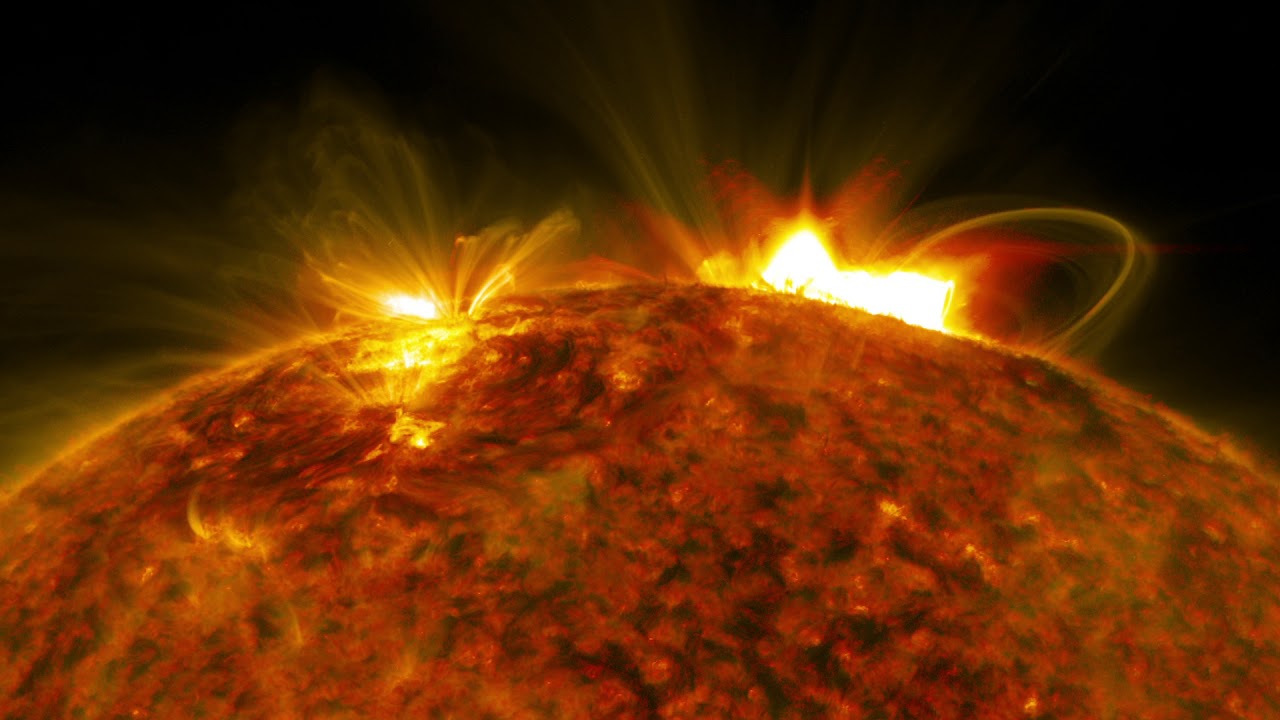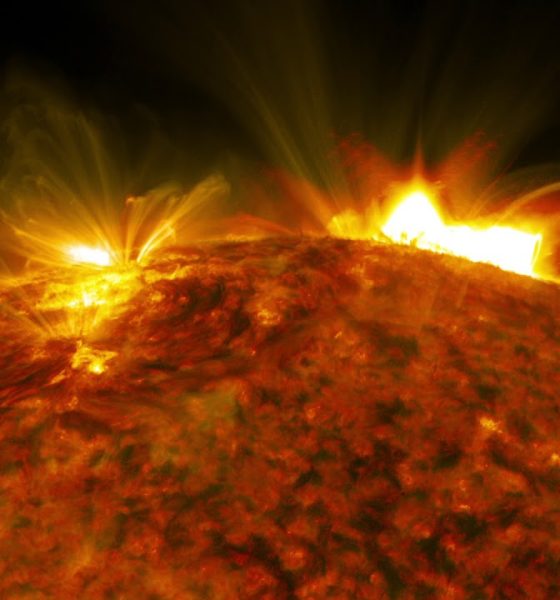

News
Space ‘superstorms’ and their impact on Earth’s protective shield
The European Space Agency (ESA) together with NASA is gearing up for the launch of the Solar Orbiter spacecraft — a 3,975-lb. (1,800 kg) sun-observing satellite.
Designed to study the sun up close, Solar Orbiter will take the first photos of the sun’s pole as well as provide scientists with crucial data to help guarantee against space weather.
Most of us look up at the sun and think of it as just a glowing orb in the sky, bathing the Earth in light, but our star has a darker, violent side. (Please do not stare directly at the sun, only Solar Orbiter is equipped to do so. Here are some safe ways to look at our host star.)
The sun regularly produces massive solar flares, which erupt on its surface, spewing X-rays and high-energy particles everywhere. Just eight minutes after the violent outburst, those same X-rays can slam into the Earth’s magnetic field. Most of the time, our protective shield keeps us protected from the sun, but it can be overwhelmed at times.
High energy particles from the sun run along magnetic field lines, like electric currents run through wires, looking for a release. Most often we see the lighter side of the sun’s wrath, in the form of auroras.
But really powerful ones can cripple communication systems and power grids. Radio signals, like the ones we use to communicate, are able to travel great distances through a section of the atmosphere known as the ionosphere. However, when a powerful solar storm is raging, those signals are cut off by the X-rays emitted by the sun and are ultimately drowned out by crackling static.
A recent study, published in the journal Geophysical Research Letters, indicates that the most powerful solar storms can hit once every 25 years, with less intense ones battering the Earth about once every three years.
The team, led by Dr. S.C. Chapman from the University of Warwick, identifies two types of powerful magnetic storms: ‘great super storms’ and ‘severe super storms.’ These two types are both considered dangerous and capable of causing damage to our valuable infrastructure here on Earth.

Also called geomagnetic storms, these cosmic tempests are caused by disturbances inside the sun that send particles streaming out into space. When they slam against our planet’s magnetosphere, they generate space weather, which can be very catastrophic to our sensitive electronics and power grids.
The most famous of these solar storms occurred in 1859. The Carrington Event is the most powerful geomagnetic storm ever recorded. It knocked out telegraph systems around the world, started a few fires, and even shocked some of the telegraph operators.
In 1989, a similar outburst caused issues in Canada. In Quebec, the province’s power supply station was disrupted and incredible auroras filled the sky with light when a wave of solar particles came in contact with the Earth. People as far south as Texas could see the dazzling light display.
https://youtu.be/17KHY3TNssQ
These disturbances look to be increasingly more common and can disrupt all sorts of technology from satellites to global communications systems and more.
The world relies heavily on satellites, which are incredibly vulnerable due to their sensitive parts. Scientists theorize that if a modern-day Carrington event were to happen, it could cost trillions of dollars worth of damages. This is why scientists are using spacecraft, like Solar Orbiter and its counterpart the Parker Solar Probe, to really understand the processes that are taking place.

News
Tesla stands to gain from Ford’s decision to ditch large EVs
Tesla is perhaps the biggest beneficiary of Ford’s decision, especially as it will no longer have to deal with the sole pure EV pickup that outsold it from time to time: the F-150 Lightning.

Ford’s recent decision to abandon production of the all-electric Ford F-150 Lightning after the 2025 model year should yield some advantages for Tesla.
The Detroit-based automaker’s pivot away from large EVs and toward hybrids and extended-range EVs that come with a gas generator is proof that sustainable powertrains are easy on paper, but hard in reality.
Tesla is perhaps the biggest beneficiary of Ford’s decision, especially as it will no longer have to deal with the sole pure EV pickup that outsold it from time to time: the F-150 Lightning.
Here’s why:
Reduced Competition in the Electric Pickup Segment
The F-150 Lightning was the Tesla Cybertruck’s primary and direct rival in the full-size electric pickup market in the United States. With Ford’s decision to end pure EV production of its best-selling truck’s electric version and shifting to hybrids/EREVs, the Cybertruck faces significantly less competition.

Credit: Tesla
This could drive more fleet and retail buyers toward the Cybertruck, especially those committed to fully electric vehicles without a gas generator backup.
Strengthened Market Leadership and Brand Perception in Pure EVs
Ford’s pullback from large EVs–citing unprofitability and lack of demand for EVs of that size–highlights the challenges legacy automakers face in scaling profitable battery-electric vehicles.
Tesla, as the established leader with efficient production and vertical integration, benefits from reinforced perception as the most viable and committed pure EV manufacturer.

Credit: Tesla
This can boost consumer confidence in Tesla’s long-term ecosystem over competitors retreating to hybrids. With Ford making this move, it is totally reasonable that some car buyers could be reluctant to buy from other legacy automakers.
Profitability is a key reason companies build cars; they’re businesses, and they’re there to make money.
However, Ford’s new strategy could plant a seed in the head of some who plan to buy from companies like General Motors, Stellantis, or others, who could have second thoughts. With this backtrack in EVs, other things, like less education on these specific vehicles to technicians, could make repairs more costly and tougher to schedule.
Potential Increases in Market Share for Large EVs
Interestingly, this could play right into the hands of Tesla fans who have been asking for the company to make a larger EV, specifically a full-size SUV.
Customers seeking large, high-capability electric trucks or SUVs could now look to Tesla for its Cybertruck or potentially a future vehicle release, which the company has hinted at on several occasions this year.
With Ford reallocating resources away from large pure EVs and taking a $19.5 billion charge, Tesla stands to capture a larger slice of the remaining demand in this segment without a major U.S. competitor aggressively pursuing it.
News
Ford cancels all-electric F-150 Lightning, announces $19.5 billion in charges
“Rather than spending billions more on large EVs that now have no path to profitability, we are allocating that money into higher returning areas, more trucks and van hybrids, extended range electric vehicles, affordable EVs, and entirely new opportunities like energy storage.”

Ford is canceling the all-electric F-150 Lightning and also announced it would take a $19.5 billion charge as it aims to quickly restructure its strategy regarding electrification efforts, a massive blow for the Detroit-based company that was once one of the most gung-ho on transitioning to EVs.
The announcement comes as the writing on the wall seemed to get bolder and more identifiable. Ford was bleeding money in EVs and, although it had a lot of success with the all-electric Lightning, it is aiming to push its efforts elsewhere.
It will also restructure its entire strategy on EVs, and the Lightning is not the only vehicle getting the boot. The T3 pickup, a long-awaited vehicle that was developed in part of a skunkworks program, is also no longer in the company’s plans.
Instead of continuing on with its large EVs, it will now shift its focus to hybrids and “extended-range EVs,” which will have an onboard gasoline engine to increase traveling distance, according to the Wall Street Journal.
“Ford no longer plans to produce select larger electric vehicles where the business case has eroded due to lower-than-expected demand, high costs, and regulatory changes,” the company said in a statement.
🚨 Ford has announced it is discontinuing production of the F-150 Lightning, as it plans to report a charge of $19.5 billion in special items.
The Lightning will still be produced, but instead with a gas generator that will give it over 700 miles of range.
“Ford no longer… pic.twitter.com/ZttZ66SDHL
— TESLARATI (@Teslarati) December 15, 2025
While unfortunate, especially because the Lightning was a fantastic electric truck, Ford is ultimately a business, and a business needs to make money.
Ford has lost $13 billion on its EV business since 2023, and company executives are more than aware that they gave it plenty of time to flourish.
Andrew Frick, President of Ford, said:
“Rather than spending billions more on large EVs that now have no path to profitability, we are allocating that money into higher returning areas, more trucks and van hybrids, extended range electric vehicles, affordable EVs, and entirely new opportunities like energy storage.”
CEO Jim Farley also commented on the decision:
“Instead of plowing billions into the future knowing these large EVs will never make money, we are pivoting.”
Farley also said that the company now knows enough about the U.S. market “where we have a lot more certainty in this second inning.”
News
SpaceX shades airline for seeking contract with Amazon’s Starlink rival

SpaceX employees, including its CEO Elon Musk, shaded American Airlines on social media this past weekend due to the company’s reported talks with Amazon’s Starlink rival, Leo.
Starlink has been adopted by several airlines, including United Airlines, Qatar Airways, Hawaiian Airlines, WestJet, Air France, airBaltic, and others. It has gained notoriety as an extremely solid, dependable, and reliable option for airline travel, as traditional options frequently cause users to lose connection to the internet.
Many airlines have made the switch, while others continue to mull the options available to them. American Airlines is one of them.
A report from Bloomberg indicates the airline is thinking of going with a Starlink rival owned by Amazon, called Leo. It was previously referred to as Project Kuiper.
American CEO Robert Isom said (via Bloomberg):
“While there’s Starlink, there are other low-Earth-orbit satellite opportunities that we can look at. We’re making sure that American is going to have what our customers need.”
Isom also said American has been in touch with Amazon about installing Leo on its aircraft, but he would not reveal the status of any discussions with the company.
The report caught the attention of Michael Nicolls, the Vice President of Starlink Engineering at SpaceX, who said:
“Only fly on airlines with good connectivity… and only one source of good connectivity at the moment…”
CEO Elon Musk replied to Nicolls by stating that American Airlines risks losing “a lot of customers if their connectivity solution fails.”
American Airlines will lose a lot of customers if their connectivity solution fails
— Elon Musk (@elonmusk) December 14, 2025
There are over 8,000 Starlink satellites in orbit currently, offering internet coverage in over 150 countries and territories globally. SpaceX expands its array of satellites nearly every week with launches from California and Florida, aiming to offer internet access to everyone across the globe.
Currently, the company is focusing on expanding into new markets, such as Africa and Asia.








